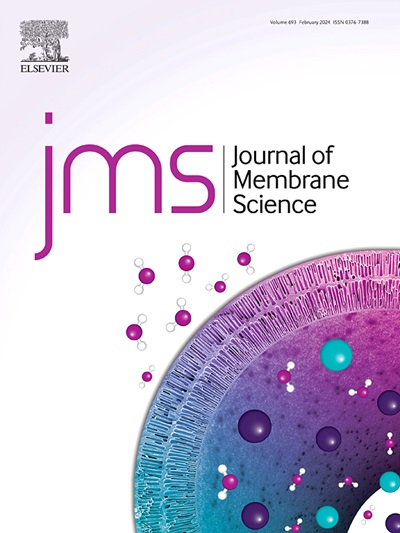Effect of ceramic substrate pore size on the structure and performance of polyamide nanofiltration membrane via interfacial polymerization
IF 8.4
1区 工程技术
Q1 ENGINEERING, CHEMICAL
引用次数: 0
Abstract
Thin-film composite (TFC) membranes prepared by interfacial polymerization (IP) have been widely used in wastewater treatment. The substrate pore size plays a critical role on the polyamide (PA) membrane performance. Herein, a variety of PA nanofiltration (NF) membranes on ceramic substrate with different pore size (5 nm (CM-5), 20 nm (CM-20), 50 nm (CM-50), and 200 nm (CM-200)) are successfully prepared via IP. The results depict that substrates with smaller pores have less absorption capacity of the aqueous monomer (piperazine). Reducing ceramic substrate pore size from 200 nm to 5 nm, the formed PA layer transforms from cracked “ridge-and-valley" structure to continuous film. Cross-sectional FESEM images further demonstrate that the PA layer thickness decreases from 106 nm to 29 nm. The pore size of the polyamide membrane on CM-20 is 0.17 nm with a water permeance of 27.3 L m−2 h−1 bar−1 and Na2SO4 rejection of ∼96 %. A smaller pore size of the ceramic substrate might reduce the available space for monomer movement, increasing the collision and reaction between the monomers, which leads to an elevated cross-linking degree of PA (a denser PA layer). Based on the nanofiltration performance, a ceramic substrate with pore size of 20 nm is optimal for the TFC membrane preparation. The obtained membrane keeps stable performance during 72 h operation. The obtained membrane also demonstrates excellent stability in high-temperature environment and in organic solvent. Overall, ceramic substrate with pore size of 20 nm is selected for the preparation of PA NF membrane via IP. The obtained membrane has broad applications in desalination and environmental remediation.
陶瓷基板孔径对界面聚合聚酰胺纳滤膜结构和性能的影响
界面聚合法制备的薄膜复合膜(TFC)在污水处理中得到了广泛的应用。底物孔径对聚酰胺(PA)膜的性能起着至关重要的作用。本文通过IP成功制备了不同孔径(5 nm (CM-5)、20 nm (CM-20)、50 nm (CM-50)、200 nm (CM-200))的陶瓷基板上PA纳滤膜。结果表明,孔越小的底物对哌嗪的吸附能力越弱。将陶瓷基板孔径从200 nm减小到5 nm,形成的PA层由断裂的“脊谷”结构转变为连续膜。横截面FESEM图像进一步表明,PA层厚度从106 nm减小到29 nm。CM-20上聚酰胺膜的孔径为0.17 nm,透水性为27.3 L m−2 h−1 bar−1,Na2SO4截留率为~ 96%。陶瓷基板的孔径越小,单体运动的可用空间就越小,单体之间的碰撞和反应就越频繁,从而导致PA交联度升高(更致密的PA层)。基于纳滤性能,孔径为20 nm的陶瓷基板是制备TFC膜的最佳材料。制备的膜在72 h内性能稳定。所制备的膜在高温环境和有机溶剂中也表现出良好的稳定性。综上所述,我们选择孔径为20 nm的陶瓷衬底通过IP法制备PA - NF膜。所得膜在海水淡化和环境修复方面具有广泛的应用前景。
本文章由计算机程序翻译,如有差异,请以英文原文为准。
求助全文
约1分钟内获得全文
求助全文
来源期刊

Journal of Membrane Science
工程技术-高分子科学
CiteScore
17.10
自引率
17.90%
发文量
1031
审稿时长
2.5 months
期刊介绍:
The Journal of Membrane Science is a publication that focuses on membrane systems and is aimed at academic and industrial chemists, chemical engineers, materials scientists, and membranologists. It publishes original research and reviews on various aspects of membrane transport, membrane formation/structure, fouling, module/process design, and processes/applications. The journal primarily focuses on the structure, function, and performance of non-biological membranes but also includes papers that relate to biological membranes. The Journal of Membrane Science publishes Full Text Papers, State-of-the-Art Reviews, Letters to the Editor, and Perspectives.
 求助内容:
求助内容: 应助结果提醒方式:
应助结果提醒方式:


